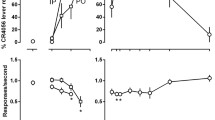Abstract
Two rhesus monkeys were trained to discriminate the IM injection of etorphine (0.001 mg/kg) from saline in a task in which 20 consecutive responses on one of two levers resulted in food delivery. In both monkeys, etorphine (0.0001–0.0018), meperidine (0.1–1.0 mg/kg), morphine (0.1–3.2 mg/kg), and codeine (0.3–3.2) produced dose-related increases in the percentage of total session responses that occurred on the etorphine-appropriate lever. In contrast, ethylketazocine, SKF-10047, and pentazocine, at doses up to and including those that suppressed response rates, produced responses primarily on the saline-appropriate lever. Thus, etorphine-like narcotics, including morphine, have discriminative stimulus effects in rhesus monkeys which can be distinguished from those produced by narcotics with nonmorphine-like actions such as ethylketazocine, SKF-10047, and pentazocine.
Similar content being viewed by others
References
Blane GF, Boura ALA, Fitzgerald AE, Lister RE (1967) Actions of etorphine hydrochloride (M99): A potent morphine-like agent. B J Pharmacol 30:11–22
Colpaert FC (1978) Discriminative stimulus properties of narcotic analgesic drugs. Pharmacol Biochem Behav 9:863–887
Downs DA, Woods JH (1976) Morphine, pentazocine, and naloxone effects on responding under a multiple schedule of reinforcement in rhesus monkeys and pigeons. J Pharmacol Exp Ther 196:298–306
Hein DW, Young AM, Herling S, Woods JH (in press) Pharmacological analysis of the discriminative stimulus characteristics of ethylketazocine in the rhesus monkey. J Pharmacol Exp Ther
Herling S, Coale EH Jr, Valentino RJ, Hein DW, Woods JH (1980) Narcotic discrimination in pigeons. J Pharmacol Exp Ther 214:139–146
Hoffmeister F (1979) Preclinical evaluation of reinforcing and adversive properties of analgesics. In: Beers RF, Bassett EG (eds) Mechanisms of pain and analgesis compounds. Raven Press, New York, pp 447–466
Johanson CE, Balster RL (1978) A summary of the results of a drug self-administration study using substitution procedures in rhesus monkeys. Bull Narc 30:43–54
Kosterlitz HW, Waterfield AA, Berthoud V (1974) Assessment of agonist and antagonist properties of narcotic analgesic drugs by their actions on the morphine receptor in the guinea pig ileum. In: Braude MC, Harris LS, May EL, Smith JP, Villarreal JE (eds) Narcotic antagonists. Advances in Biochemical Psychopharmacology. Raven Press, New York, Vol 8, pp 319–334
Lal H, Gianutsos G, Miksic S (1977) Discriminable stimuli produced by analgesics. In: Lal H (ed) Discriminative stimulus properties of drugs. Plenum Press, New York, pp 23–45
Schaefer GJ, Holtzman SG (1977) Discriminative effects of morphine in the squirrel monkey. J Pharmacol Exp Ther 201:67–75
Shannon HE, Holtzman SG (1976) Evaluation of the discriminative effects of morphine in the rat. J Pharmacol Exp Ther 198:54–65
Teal JJ, Holtzman SG (1980) Discriminative stimulus effects of cyclazocine in the rat. J Pharmacol Exp Ther 212:368–376
Woods JH, Smith CB, Medzihradsky F, Swain HH (1979) Preclinical testing of new analgesic drugs. In: Beers RF, Bassett EG (eds) Mechanisms of pain and analgesic compounds. Raven Press, New York, pp 429–445
Young AM, Herling S, Winger GD, Woods JH (1980) Comparison of discriminative and reinforcing effects of ketamine and related compounds in the rhesus monkey. Reported to the 42nd Scientific Meeting of the Committee on Problems of Drug Dependence, Inc. NIDA Research Monograph Series 1980
Young AM, Woods JH (1980) Behavior maintained by intravenous injection of codeine, cocaine, and etorphine in the rhesus macaque and the pigtail macaque. Psychopharmacology 70: 263–271
Author information
Authors and Affiliations
Rights and permissions
About this article
Cite this article
Herling, S., Woods, J.H. Discriminative stimulus effects of etorphine in rhesus monkeys. Psychopharmacology 72, 265–267 (1981). https://doi.org/10.1007/BF00431828
Received:
Accepted:
Issue Date:
DOI: https://doi.org/10.1007/BF00431828




